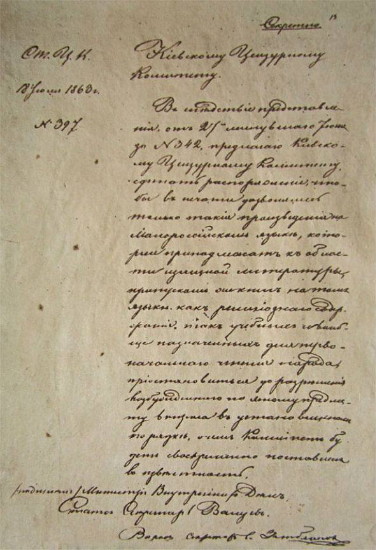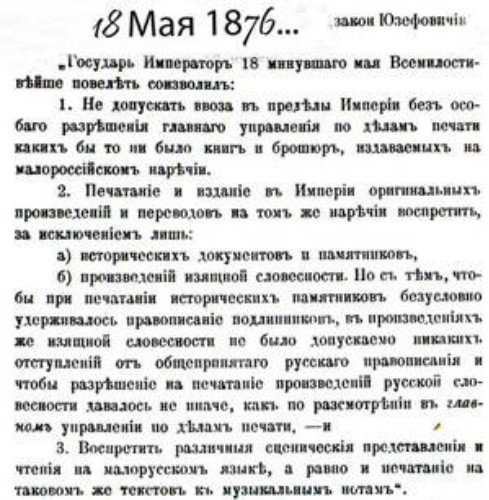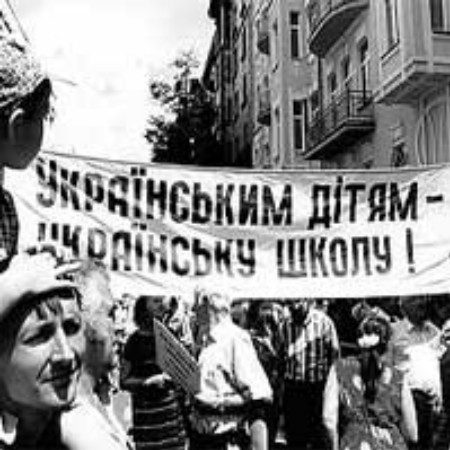Russification
Russification [русифікація; rusyfikatsia]. A set of policies or processes encouraging non-Russians to adopt the Russian language and culture and thus increasing Russian political domination in Ukraine and other Eastern European countries.
The rapid expansion of Muscovy and then of the Russian Empire was connected with the Russification of the indigenous peoples of eastern Europe and northern and central Asia. The smaller nations or tribes were assimilated by the Russians. The most ambitious and talented elements of various nationalities were drawn to the administrative, industrial, and cultural centers of the empire and became Russified. Also Russified were many scholars and specialists from Western Europe who made their careers in Russia. Some figures of Balkan and even Polish and Galician (see Russophiles) origin looked toward a powerful Russia for protection against Turkey or Germany (or Austria) and became Russified.
Ukraine came under increasing Russification pressures after the Pereiaslav Treaty of 1654. Ukrainian autonomy was gradually restricted and finally abolished. In 1720 it was forbidden to print books in Ukrainian, and Ukrainian redactions of Church Slavonic books had to be checked against Russian redactions ‘to avoid any discrepancies.’ The Governing Council of the Hetman Office (est 1734) was given secret instructions to promote the merging of the two nations through intermarriage. During the reign of Catherine II a wide Russification program was implemented in Ukraine by the Second Little Russian Collegium under Petr Rumiantsev. Russian became compulsory in the schools and in publications. The language of instruction at the Kyivan Mohyla Academy was switched to Russian. Russian was adopted as the administrative language in the Orthodox church, and Church Slavonic, used for sermons, had to be pronounced in the Russian way. The Holy Synod in 1769 did not permit the Kyivan Cave Monastery to print primers in Ukrainian. The policy of Russification was extended gradually into all spheres of social life, first in Left-Bank Ukraine, Kyiv, and Slobidska Ukraine, and after the suppression of the Polish Insurrection of 1830–1 in Right-Bank Ukraine as well.
The imperial government sharply increased its Russification efforts in the second half of the 19th century: the Valuev circular (1863) and the Ems Ukase (1876) blocked the development of Ukrainian literature until the Revolution of 1905. Even then some restrictions on the Ukrainian language and literature remained in force, and during the First World War Ukrainian publications were banned in Ukraine. Nevertheless, in spite of government efforts, until 1917 Russification was limited largely to the cities and industrial centers, which were inhabited by Russians and the higher strata (the intelligentsia, landowners, clergy, and burghers) of the indigenous society. Some members of these strata maintained Ukrainian traditions, language, and culture. The bulk of the Ukrainian population, the peasantry, remained Ukrainian and was not deeply affected by the Russification of education and church life. Yet long years of military service left a lasting mark on a limited segment of the common people.
The national revival and de-Russification of Ukraine that began with the Revolution of 1917 was interrupted by the Soviet occupation in 1919–20. With the consolidation of Soviet power the Russians regained their dominant position in Ukraine. Russian became the language of the Communist Party and government: most of the official press, decrees, and announcements were published in Russian. Most of the books printed in 1919–23 were Russian. The Ukrainization of the Soviet Ukrainian government and the educational and cultural institutions met with much opposition from Russians and Russified elements. Soon after its inauguration in 1923, the process was slowed down. In 1927 the Central Committee of the Communist Party of Ukraine decided to ‘recognize the special importance of the Russian language.’ By 1930 there was active opposition to Ukrainization in the Party and a demand to revoke the policy. In 1932–3 the Party switched to an extreme anti-Ukrainian course: the cultural, state, and Party activists who had implemented Ukrainization were arrested and either imprisoned or shot. Ukrainization in the Kuban and other regions of the Russian Soviet Federated Socialist Republic settled by Ukrainians was replaced by intensified Russification.
In contrast to the tsarist period, under the Soviet regime Russification encompassed all Ukrainian territories, administrative and ethnic, and all social strata, including the peasantry. It was conducted by the enormous state and Party machine with the active support of the Russian minority in Ukraine and the Russian Orthodox church. Russification efforts after the Second World War, particularly in newly annexed Western Ukraine, gave rise at the beginning of the 1960s to a dissident movement among Ukrainian intellectuals and some workers. They demanded that Ukrainian be introduced as the language of instruction in higher education and special secondary schools and in preschool education and as the language of administration in public institutions, enterprises, communications, and trade. They wanted the Academy of Sciences, the universities, and state publishers to issue more publications in Ukrainian. The government responded with repressions and increasing Russification pressures.
Soviet efforts at Russifying the non-Russian nationalities were based on a Soviet theory of the merging of nations. The theory tacitly assumed that the one Soviet nation being formed was Russian in language and culture. Shortly after Nikita Khrushchev came to power, he adopted an insidious plan to force the non-Russian languages out of elementary schools and secondary education. In April 1959 a new law was passed by the Supreme Soviet of the Ukrainian SSR giving parents the right to decide which schools, Russian-language or native-language, their children would attend. Given the state-bestowed advantages enjoyed by Russian-speakers in higher education, political and economic institutions, and cultural life, this seemingly democratic law was designed to make the non-Russian nationalities the agents of their own Russification. The Tashkent Conference of 1975 was devoted to ways of improving the teaching of Russian to non-Russian children. The Ukrainian Ministry of Education developed a plan in 1983 for upgrading Russian-language instruction in Ukraine. By 1987 only 16 percent of the schools in the national and oblast capitals were Ukrainian, 12 percent were mixed (predominantly Russian), and 72 percent were Russian. In Chernihiv, Donetsk, Simferopol, and Luhansk there were no Ukrainian schools at all.
Apart from pedagogical schools, vocational-technical schools and specialized secondary schools were almost completely Russified by the 1960s. This was true of higher education as well. Except in the departments of Ukrainian language and literature only Russian was used at the Dnipropetrovsk University, Odesa University, Kharkiv University, and Donetsk University. At Kyiv University, Lviv University, Uzhhorod University, and Chernivtsi University some lecturers in the social sciences used Ukrainian. All the polytechnical, medical, industrial, commercial, agricultural, and economic institutes, except for a few in the western oblasts, taught only in Russian. In 1960 only 62.5 percent of the students in Ukraine’s higher educational institutions were Ukrainians (30 percent were Russians), and only 58.3 of the specialists with a higher education in Ukraine were Ukrainians (26.5 percent were Russians). In 10 years the number of higher education textbooks in Ukrainian fell from 168 titles (1970) to 38 (1980), while those in Russian rose from 263 to 422. All candidate and doctoral dissertations submitted in the Academy of Sciences of the Ukrainian SSR were written in Russian.
The scientific literature published in Ukraine indicated strong discrimination in favor of Russian. Of 947 scientific titles published in Ukraine in 1970, 64.3 percent were in Russian. By 1980 Russian titles constituted 86.5 percent. Similarly, the percentage of Russian-language journals published by the Academy of Sciences of the Ukrainian SSR rose from 36.6 in 1969 to 76.2 in 1980. The production of Ukrainian books and booklets in general fell from 4,041 titles in 1961 to 2,981 in 1973, while the number of Russian titles remained unchanged at slightly above 4,400. The number of Ukrainian journals increased from 51 in 1961 to 63 in 1970 and fell to 50 in 1980, while the number of Russian journals published in Ukraine rose steadily from 26 to 41 to 50. Moreover, most of the Ukrainian journals were devoted to literature and art. According to some estimates the Ukrainian-language holdings of public libraries in Ukraine accounted for only 10 to 20 percent of the total holdings. Discrimination in favor of Russian culture was evident also in other fields; the number of museums in Ukraine, for example, fell from 174 in 1940 to 147 in 1972, while in RSFSR the number rose from 592 to 610. The most frequent and available radio and TV programs in Ukraine were Russian, either produced in Ukraine or broadcasted from RSFSR.
Buttressing the efforts at Russification was a widespread attitude that the Soviet people could gain access to world culture and science only through Russian. A subtle form of Russification was practiced by linguistic institutes: their task was to make the vocabulary and grammar of literary and scientific Ukrainian increasingly similar to Russian (see Standard Ukrainian).
The central government resettled people and manipulated migration patterns so as to promote Russification (see National composition of Ukraine and Migration). Russians were encouraged in various ways to move to Ukraine, and large numbers of them were settled there. Whereas Russians accounted for only 8.2 percent of Ukraine’s (within its postwar borders) population in 1926, by 1959 they accounted for 16.9 percent, and by 1989, for 22.1 percent. The practice of resettling whole villages from the Russian Soviet Federated Socialist Republic to Ukraine continued even under perestroika. At the same time millions of Ukrainians were resettled by force or attracted by various incentives to move to other parts of the USSR. By 1989 there were, for example, 185,000 Ukrainians in the Baltic states, whereas before 1945 there were virtually none. In 1989 almost 6.8 million Ukrainians were scattered throughout the USSR outside Ukraine.
The success of the different Russification policies is evident to some extent in the linguistic assimilation of Ukrainians. In 1926, 4.5 percent of Ukrainians in Ukraine considered Russian their native tongue. By 1959 this figure had risen to 6.5, and by 1989, to 12.2. In 1989, 78 percent of Ukraine’s population was fluent in Ukrainian, and 78.4 percent, in Russian. Russian is more prevalent in the urban areas, where only 72.1 percent of the residents are fluent in Ukrainian but 87.4 are fluent in Russian. The most Russified oblasts in Ukraine are those in which Russians constitute the highest percentage of the population: Crimea, Donetsk oblast, Luhansk oblast, Kharkiv oblast, Odesa oblast, and Dnipropetrovsk oblast.
Ukrainians in other Soviet republics were subjected to even stronger Russification pressures. They had no national rights—no Ukrainian schools and no Ukrainian publications (books and press) of their own. Likewise, access to Ukrainian materials from Ukraine was made difficult for them. Ukrainians in the Russian Soviet Federated Socialist Republic along the Ukrainian border (in Belgorod oblast, Kursk oblast, Voronezh oblast, and part of Rostov oblast and Krasnodar krai) constituted 66 percent of the population there in 1926. By 1970 only 9 percent of the population in the same regions was Ukrainian. In Northern Caucasia the percentage of Ukrainian inhabitants fell from 33.4 in 1926 to 2.3 in 1970. In 1926 there were 2,318,000 Ukrainians in the Asiatic part of the USSR, and in 1970 there were 2,235,000.
When Mikhail Gorbachev’s policy of glasnost made it possible to discuss basic social problems, Russification became one of the first and central issues to be raised in the Ukrainian press. The Taras Shevchenko Ukrainian Language Society was founded in February 1989 to revive the Ukrainian language in Ukraine, and at the end of October 1989 the Supreme Soviet of the Ukrainian SSR adopted the Languages Act establishing Ukrainian as the republic’s official language. The accompanying schedule for the conversion of state institutions, enterprises, civic organizations, and mass media to Ukrainian was based on the premise that the effects of Russification could be overcome only gradually, through patient and persistent effort.
BIBLIOGRAPHY
Dzyuba, I. Internationalism or Russification? (London 1968; 2nd edn, New York 1974)
Kolasky, J. Education in Soviet Ukraine (Toronto 1968)
Sahaydak, M. (comp). Ethnocide of Ukrainians in the USSR, trans O. Saciuk and B. Yasen (Baltimore–Paris–Toronto 1976)
Motyl, A. J. Will the Non-Russians Rebel? State, Ethnicity, and Stability in the USSR (Ithaca and London 1987)
Solchanyk, R. ‘Ukraine, Belorussia, and Modavia: Imperial Integration, Russification, and the Struggle for National Survival,’ in The Nationalities Factor in Soviet Politics and Society, ed L. Hajda and M. Beissinger (Boulder, Colo, and Oxford 1990)
Bohdan Kravtsiv, Volodymyr Kubijovyč
[This article originally appeared in the Encyclopedia of Ukraine, vol. 4 (1993).]



